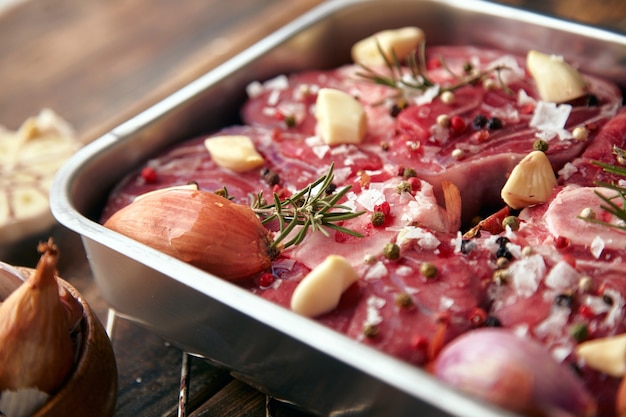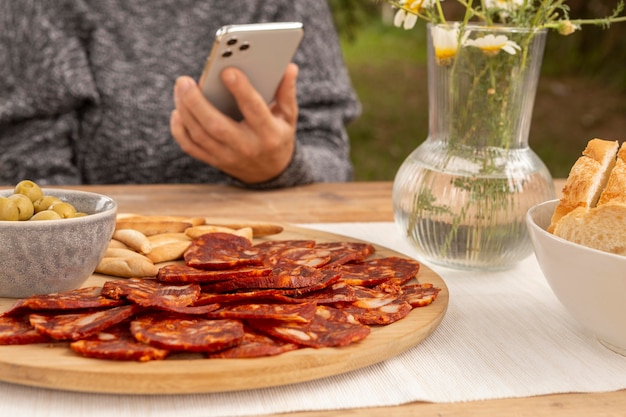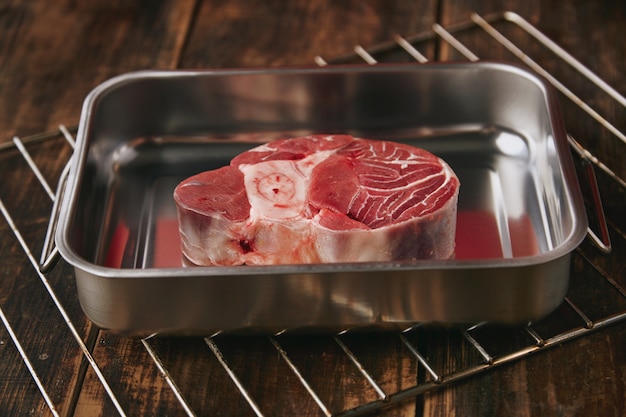Bacon. Just the word conjures up images of crispy, salty goodness, a breakfast staple that brings joy to any meal. While pan-frying has always been the go-to method, I've found that oven-baked bacon is a revelation. It's hands-off, produces consistent results, and lets you cook a massive batch without needing to babysit the stove. But achieving that perfect crisp, the kind that shatters with a delightful crunch, without venturing into burnt territory can be tricky. So, buckle up, fellow bacon enthusiasts, because we're diving deep into the art of oven-baked bacon, unlocking the secrets to crispy perfection.
Part 1: The Foundation: Your Equipment

Before we even think about bacon, let's set the stage for success. The right equipment makes all the difference, ensuring that your bacon cooks evenly and the mess stays contained.
The Baking Sheet: A Solid Base
Imagine this: you've just pulled a tray of golden, sizzling bacon out of the oven, only to discover a puddle of grease that threatens to engulf your kitchen. Not a pretty picture, right? That's why a good baking sheet is crucial. You want one with a rim, a little barrier against any adventurous bacon fat droplets. I swear by those with a nonstick coating – they make cleaning up a breeze, and you can practically feel the guilt lift off your shoulders.
If you're a purist who prefers the classic uncoated baking sheet, no judgement here. Just make sure to line it with either parchment paper or aluminum foil. This prevents sticking, making it easier to slide that glorious bacon off the sheet. I personally prefer parchment paper – it's more forgiving than foil, less likely to tear or warp, and holds its shape better in the heat.
The Wire Rack: The Secret Weapon
Here's where things get interesting. This is the secret weapon that transforms your bacon from good to truly remarkable: a wire rack. Instead of directly on the baking sheet, place the bacon on the rack, positioned above the baking sheet. This lets hot air circulate freely around each strip, resulting in even cooking and that satisfyingly crisp texture you crave. Plus, it allows the fat to drip down onto the baking sheet below, leaving you with a delicious treasure trove of rendered bacon fat, perfect for frying eggs, roasting vegetables, or even adding a flavour bomb to your salad.
You can buy a dedicated bacon rack, or use a simple cooling rack, just make sure it's sturdy enough to support the bacon. I find a rack with slightly raised edges is even better, preventing the bacon from sliding around during cooking. It's like a little bacon haven, keeping it in place while it crisps to perfection.
Part 2: The Star of the Show: Your Bacon

Now, let's talk about the star of the show, the bacon itself. choosing the right bacon is as important as the oven temperature, and it’s all about finding the perfect balance of thickness, flavor, and texture.
Thickness Matters: Finding the Right Cut
Thickness is king when it comes to oven-baked bacon. Thicker cuts tend to cook more evenly, holding their shape beautifully and producing that satisfyingly chewy texture. My personal preference leans towards thick-cut bacon, usually about 1/4 inch thick. It takes a little longer to cook, but trust me, it's worth the wait. The texture is simply divine, like a little piece of bacon heaven.
Beyond Classic: Exploring bacon varieties
The world of bacon is vast and exciting, offering a symphony of flavors and textures to suit every palate. From classic smoked bacon, with its deep, smoky aroma, to sweet and savory maple-infused, peppered, or even applewood-smoked varieties, the choices are endless. It's a bacon adventure waiting to be explored.
Don't be afraid to experiment with different types. You might discover a new favourite. For me, it's the smoky depth of traditional smoked bacon that I gravitate towards, but I also appreciate the sweetness of maple bacon for a delightful change of pace.
Part 3: The Starting Line: Pre-heating and Arrangement

We're nearing the starting line, but before we send our bacon into the oven, we need to make sure it's ready for the race. Preheating is a crucial step, ensuring that your bacon cooks evenly and avoids any embarrassing undercooked or overcooked moments.
Preheating the Oven: Setting the Stage
I always preheat my oven to 400°F (200°C). This temperature, in my experience, delivers the perfect balance of crispy edges and a juicy, tender center. But hey, everyone has their preferences. You can adjust the temperature depending on your desired level of crispiness.
Arranging the Bacon: Strategic Placement
Once your oven is nice and toasty, it's time to arrange your bacon. For maximum airflow and even cooking, the key is a single layer, with a little space between each strip. Don't overcrowd the baking sheet, or your bacon might end up steamy and soft instead of gloriously crispy. If you have a lot of bacon to cook, use multiple baking sheets to ensure even cooking.
Part 4: The Culinary Dance: The Baking Process
The moment of truth has arrived, and it's time to bake our bacon to crispy perfection. This is where the magic happens, and with a little knowledge and practice, you'll be turning out perfectly cooked bacon every time.
The First Bake: Building the Base
Slide that baking sheet with your carefully arranged bacon into the preheated oven. I typically bake bacon for 15-20 minutes, flipping it halfway through. This ensures both sides are cooked evenly and develops that delightful even crispiness. But remember, cooking times can vary depending on the thickness of your bacon and your personal preference for crispiness.
Keep a close eye on your bacon and adjust the baking time as needed. You'll know it's ready when the edges are golden brown, crispy, and the fat has rendered down. But don't overcook it! Burnt bacon is a culinary tragedy. If you're unsure, a quick peek at the bottom of the bacon will reveal its level of doneness.
The Second Bake: Boosting the Crisp
Now, here's a secret weapon that will truly elevate your oven-baked bacon game: a second bake. After the initial bake, remove the bacon from the oven and let it rest for a few minutes. This gives the fat a chance to solidify, making it easier to transfer to a cooling rack.
Now, crank up the oven temperature to 450°F (230°C). Return the bacon to the oven for another 2-3 minutes. This high-heat blast will give your bacon an extra dose of crispiness, creating that irresistible crunch. But keep a close eye on it, because this step is where the risk of burning lurks.
The Cooling Process: Draining and Crispifying
Once your bacon has reached its glorious peak of crispiness, remove it from the oven and transfer it to a wire rack placed over a baking sheet. This allows any excess fat to drip away, preventing sogginess and allowing the bacon to continue crisping. Let it cool for a few minutes before serving or storing. The perfect finish for a perfect bacon experience.
Part 5: The Quest for Crispiness: Mastering the Crunch
Let's be honest, the most important aspect of oven-baked bacon is achieving that glorious, irresistible crunch. It's the symphony of textures, the satisfying snap that elevates bacon from good to incredible. But achieving this perfect crispiness is an art, a delicate dance between heat, time, and personal preference.
The Dance of Heat: Finding the Right Temperature
The temperature at which you bake your bacon plays a crucial role in its level of crispiness. For that satisfyingly crispy bacon, I recommend a higher temperature like 400°F (200°C). But if you prefer a slightly softer bacon, you can lower the temperature to 350°F (175°C). Just remember to adjust the cooking time accordingly.
The Second Bake: A Boost for Extra Crisp
If you find that your bacon isn't as crispy as you'd like after the initial bake, don't despair! You can always give it a second blast in the oven at a higher temperature. Just keep a close eye on it to prevent burning. The second bake is your secret weapon for achieving that ultimate crunch.
Part 6: The Golden Treasure: The Bacon Fat
Let's talk about one of the unexpected blessings of oven-baked bacon – the golden treasure that collects at the bottom of the baking sheet. This rendered bacon fat, also known as "lard," is a culinary gem, bursting with flavor and versatility.
Save the Fat: A Culinary Treasure
Don't even think about discarding this liquid gold! It's a fantastic ingredient for elevating your cooking. Use it to fry vegetables, cook eggs, or even create delicious homemade potato chips. You can store the bacon fat in a container in the refrigerator. It will solidify as it cools, but simply melt it gently on the stovetop before using it. It's like having a little bit of bacon magic in your kitchen.
Part 7: Serving and Storing: Enjoying Your Crispy Creation
Your bacon is finally ready, perfectly cooked, and exuding that irresistible aroma of crispy goodness. It's time to enjoy your culinary masterpiece.
Serving Suggestions: A Symphony of Flavors
Serve it warm alongside your favorite breakfast dishes, add it to sandwiches and salads, or simply indulge in it straight from the pan. The possibilities are endless. Bacon is a versatile ingredient that complements any meal, adding a delicious salty kick.
Storing Leftovers: Preserving the Flavor
If you have leftover bacon, store it in an airtight container in the refrigerator. It will keep for up to a week. But I find that bacon is best enjoyed within a few days, when its crispiness is at its peak.
Part 8: Frequently Asked Questions: Solving the Bacon Mysteries
FAQs
Here are some commonly asked questions about the art of oven-baked bacon, addressing the mysteries that often arise in the kitchen.
| Question | Answer |
|---|---|
| Can I bake bacon with other ingredients? | Absolutely! You can bake bacon with onions, peppers, tomatoes, or other ingredients. Just make sure to arrange them in a single layer on the baking sheet, leaving space between the bacon and other ingredients for even cooking. It's a great way to create delicious bacon-infused dishes. |
| How do I know when the bacon is cooked? | The edges of the bacon should be crispy and golden brown, and the fat should have rendered down. You can also check the bottom of the bacon for a slight brown color. If you're still unsure, a gentle poke with a fork will give you a good indication of its doneness. |
| Can I bake bacon on a wire rack without a baking sheet? | It's not recommended to bake bacon directly on a wire rack without a baking sheet underneath. This can create a messy situation as the fat will drip onto the oven floor, potentially causing smoke and fire hazards. It's always better to play it safe and use a baking sheet beneath the wire rack to catch any drippings. |
| What should I do with the bacon fat? | Bacon fat, also known as lard, is a culinary treasure. It's incredibly flavorful and versatile. Use it for cooking vegetables, eggs, or even making delicious homemade potato chips. Store it in a container in the fridge for later use. Remember, don't discard this liquid gold! |
| Can I use parchment paper instead of aluminum foil? | Yes, parchment paper is a great alternative to aluminum foil for baking bacon. It's non-stick and prevents the bacon from sticking to the baking sheet. Just make sure to use parchment paper that is specifically designed for baking. |
Conclusion: Your Journey to Crispy Bacon Bliss
Oven-baked bacon is a simple, delicious, and rewarding experience. With a little knowledge, practice, and a dash of culinary confidence, you can achieve perfectly cooked, crispy, and flavorful bacon every time. So, gather your ingredients, preheat your oven, and embark on a journey to crispy bacon bliss. Your taste buds will thank you.
Everyone is watching

How to Cook Frozen Lobster Tails Perfectly: A Step-by-Step Guide
RecipesLobster. Just the word conjures up images of lavish meals, special occasions, and a taste of luxury. But let's...

Pigs in a Blanket Cooking Time: How Long to Bake for Perfect Results
RecipesAh, pigs in a blanket. Just the name conjures up images of those delightful little parcels of crispy pastry en...

Pork Fillet Cooking Time: How Long to Cook It Perfectly
RecipesPork fillet, or tenderloin as it's sometimes called, is a real favourite in our house. It's so versatile, and...

The Ultimate Guide to Cooking Delicious Frankfurters
RecipesLet's face it, we all love a good frankfurter. It's a classic, simple, and always satisfying. But let's be rea...

Wolf Meat Recipes: A Guide to Cooking Wild Game
RecipesLet's be honest, you don't see wolf meat at your local butcher shop every day. It's a bit of a wild card, but ...
